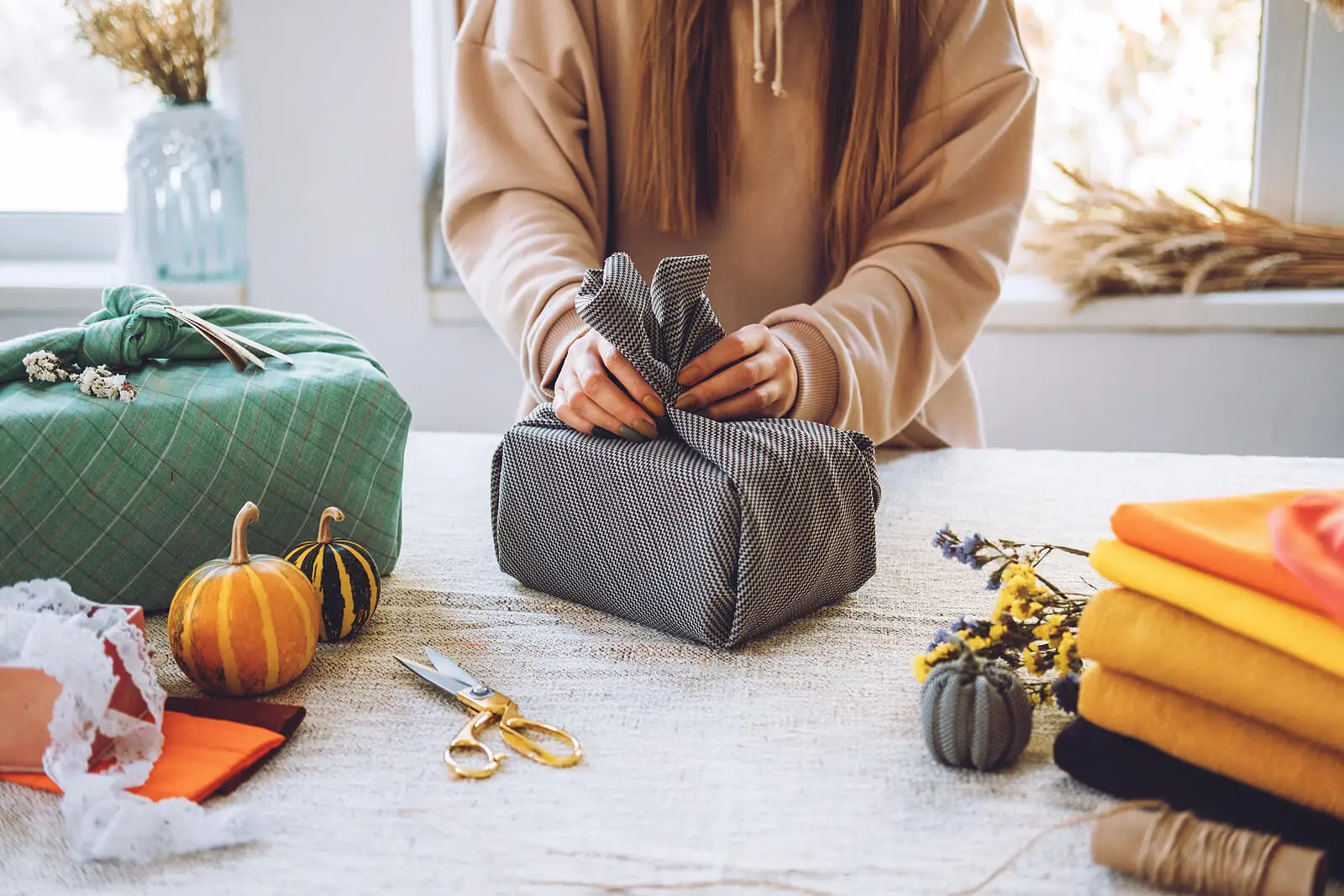Furoshiki, the Eco-friendly Gift-Wrapping Trend that's Sweeping Social Networks

There is a technique for giving gifts without spending money on disposable paper or bows. It’s known as furoshiki and comes from Japan. It consists of taking a square or rectangular cloth and performing a series of steps to cover bottles, boxes, appliances, or any object of small to medium size.
It has long gained popularity through social networks due to the advantages of its use. This is a method that combines environmental care with the delicacy and decorative aesthetics that characterizes Japanese art. In addition, it can be applied in different formats and presentations. Let’s take a closer look.
What is furoshiki and where does it come from?
Furoshiki can refer to two things; on the one hand, to the oriental technique applied to wrap objects in order to transport them or give them as a gift. On the other hand, it refers to the fabric used for this technique, originally made of silk.
However, nowadays you can find examples with different fabrics, such as cotton or nylon, as long as they’re resistant textiles. Regardless of this, it encompasses a series of wrapping techniques, which are ideal for giving birthday or Christmas gifts.
In addition, it saves the cost of wrapping paper and plastic bags. The latter is one of the most environmentally damaging polluting objects. For this reason, the Japanese government itself carried out a campaign to recover the traditional practice of furoshiki.
To do it, it’s enough to take any unused cloth, whether handkerchiefs, tablecloths, or shirts. After giving it a rectangular shape, just follow a series of steps to wrap it using this Japanese technique.

The origin of furoshiki
The furoshiki technique has ancient origins, dating back to at least the eighth century AD. At that time it was used to store Buddhist relics. Later, the nobility began to use it for clothing storage. It was especially popular during the Heian period (794-1185), which is considered the last classical period in Japanese history.
However, it gained its greatest popularity during the Muromachi era. That is, between 1333 and 1573, also during the Edo period, which lasted from 1603 to 1868. It’s therefore a practice with centuries of history. The term spread along with the Japanese bathhouses, known as onsen.
With the handkerchief called furoshiki, attendants wrapped their clothes before immersing themselves in the hot springs, so as not to get confused when picking them up. This explains the literal translation of the term, i.e. ‘bathing cloth’. Decades later, merchants used it to carry their goods. Hence its derivation into current usage.
The meaning behind this technique
Like many terms and practices of Japanese origin, furoshiki hides deep meanings in its application. In general, the art of packing implies a gesture towards the person who receives it. Beyond this, it expresses respect, dedication, and love, which is encompassed in the term tsutsumu.
In addition, when an object is packed with cloth, it’s necessary to close it with a knot. This knotting brings with it an expression of the union between people or, in Japanese terms, musubu.
We think you may be interested in reading this, too: Shoku Iku: The Japanese Philosophy of Healthy Eating
5 ideas to try furoshiki
This technique works with any color and print, without the need to get a particular fabric. The format of the furoshiki depends on personal taste and what is considered appropriate for the recipient. Flowered, dotted, or with hearts, Japanese wrappings decorate presents in a subtle and aesthetic way.
With them, it’s possible to wrap clothes, toys, boxes, electronic devices and even glass bottles. They’re even useful for creating a moving bag. There are dozens of ideas and formats to apply them. Here are some of the most popular ones on social networks.
1. A gift bag
If you bought a gift in a store, it’s very likely that it comes in a paper bag. This typical packaging can be embellished following the principles of furoshiki. Simply place it in the center of an extended square handkerchief.
Then, lift and tie the two ends of the same side on the handles. Do the same movement with the ends of the remaining side. Leave the rest of the fabric free to tie a final knot and deliver the gift in a more beautiful way.
2. General Furoshiki
The most common way to apply this technique is to place the object on one of the vertices of the outstretched handkerchief. Then, take the opposite end and cover the whole thing by giving a complete turn on it.
The other two ends of the handkerchief will be free to raise them and make a knot to seal the wrapping. Works great with notebooks, books, and small accessories.
3. Wrapping bottles
One of the most practical functions of the furoshiki is to wrap bottles of any material, even glass. The Japanese call this bin Tsutsumi, and it consists of placing the bottle standing in the center of the extended cloth.
The next step is to take two ends facing each other and join them with a knot over the spout. The remaining ends are brought together and tied in the center, bordering the bottle for added protection.
4. Furoshiki-style boxes
A gift box can also be embellished using this technique. To achieve this, place it in the center of the fabric, tie two ends on top of it, and tie a top knot with the remaining sides.
This is a similar technique to #2, but the object is placed in the center. Also, it works for larger gifts, as long as the textile covers it in its entirety.

Like this article? You may also like to read: High Life Expectancy: Why Do the Japanese Live Longer?
5. A bag with a handle
To transform a handkerchief into a comfortable bag with handles, take two large rings and place them at opposite ends of the fabric. Then, you will have to pierce two ends around one hoop and tie them with a knot.
Then, you will have to perform the same action on the other side. When lifted, the result is a bag with handles for gripping and storage space.
Furoshiki: Practicality, recycling, and significance
With any of these methods for wrapping objects following the principles of furoshiki, you can obtain new packaging that stands out for its originality. At the same time, a deep feeling of union and respect is expressed thanks to the emotional charge of this Japanese technique.
All cited sources were thoroughly reviewed by our team to ensure their quality, reliability, currency, and validity. The bibliography of this article was considered reliable and of academic or scientific accuracy.
- Compromiso mundial para reducir los plásticos de un solo uso. (2019). United Nations News. Recuperado de: https://news.un.org/es/story/2019/03/1452961
- Gómez, S. B. (2013). Redes de asociaciones y umbrales en la construcción identitaria en la comunidad Japonesa de Argentina. Redes. Revista Hispana para el Análisis de Redes Sociales, 24(2),156-187. Recuperado de: https://www.redalyc.org/articulo.oa?id=93129550007
- Hinchman, M. (2022). furoshiki. In The Fairchild Books Dictionary of Interior Design. Fairchild Books. https://doi.org/10.5040/9781501365171.1747
- Nasution, R. S. (2015). Berbagai Cara Penanggulangan Limbah Plastik. Elkawnie: Journal of Islamic Science and Technology, 1(1), 97–104. Retrieved from https://jurnal.ar-raniry.ac.id/index.php/elkawnie/article/view/522
This text is provided for informational purposes only and does not replace consultation with a professional. If in doubt, consult your specialist.








